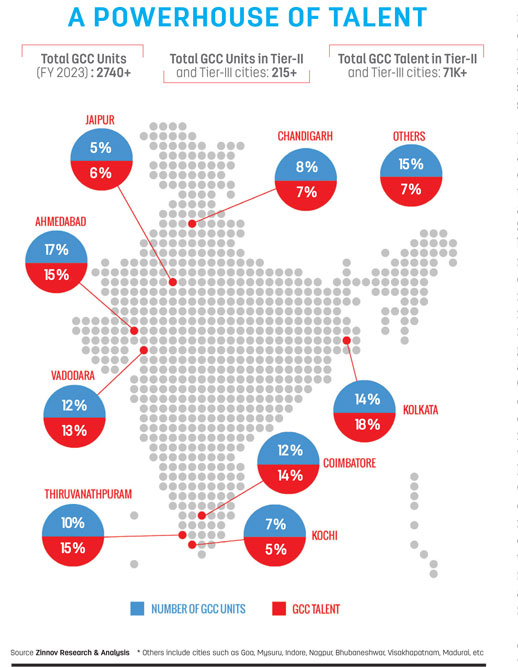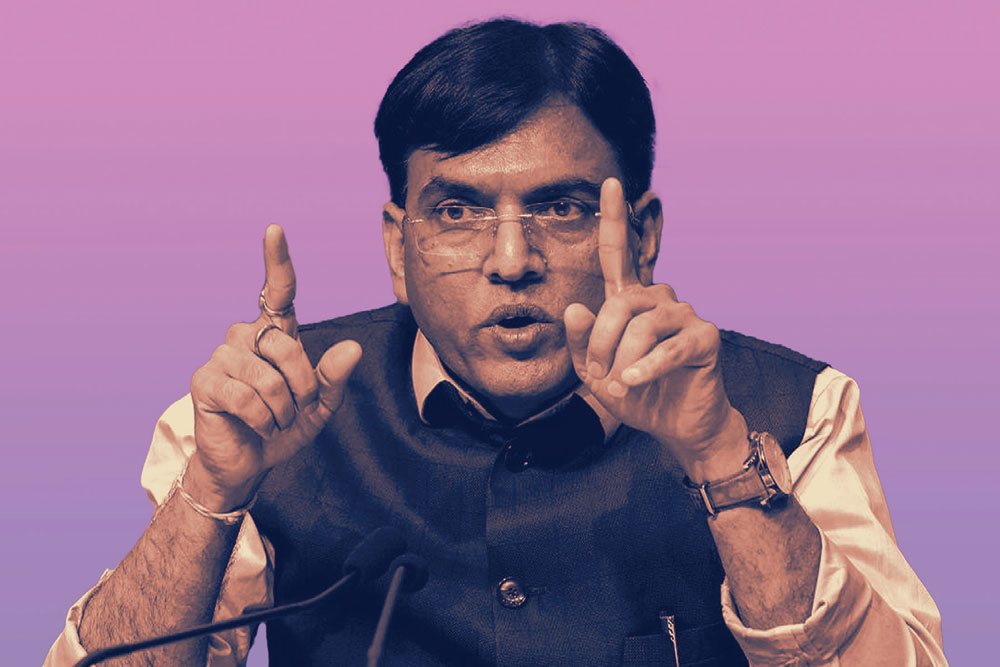Bigger Than a Back Office
The rapid expansion of global capacity centres in India is marked by innovation and high tech that can fuel growth and raise incomes
 Rajeev Deshpande
Rajeev Deshpande
 Rajeev Deshpande
Rajeev Deshpande
 |
14 Jul, 2023
|
14 Jul, 2023
/wp-content/uploads/2023/07/BackOffice1.jpg)
(Illustration: Saurabh Singh)
American political commentator Thomas L Friedman, author of the 2005 prize-winning book The World is Flat, described the benefits of the rise of India’s IT sector as not only providing employment to millions but also preventing the spread of terrorism and extremism. “Imagine if one-fifth of humanity living in India were living like the people in Iraq today, blowing up each other in their houses of worship and on the streets,” he told an interviewer in 2006. In his book, Friedman correctly recognised the growth of India beyond just an “off shoring” centre or a supplier of cheap English-speaking hires. What he may not have reckoned with was India’s transformation into an innovation hub delivering solutions integral to the growth plans of hundreds of top global companies.
The journey from being a cost arbitrage destination or a ‘back office’ to the world to the point where every second global capacity centre (GCC) is being set up in India has not been always regarded as so certain. As recently as May 2021, a leading UK financial daily questioned whether India’s off-shoring business faced its “hour of reckoning” in the wake of the deadly Delta second wave disrupting operations. The “India model” was seen at risk, impacting global banks and technology companies. The doomsday prophesies failed as India overcame the supply constraints in anti-Covid vaccines by August 2021, and when the third wave arrived in January 2022, casualties were low and infections subsided fast.
The National Association of Software and Service Companies (NASSCOM) vice president for industry initiatives, KS Viswanathan, is dismissive of terms like ‘outpost’ and ‘captive centres’, sometimes used to describe the operations of MNCs in India. “The time when operations here could be largely described as ‘lift and shift’ and were typically about cost is over. The phase where offices here were ‘satellite’ stations focusing on delivery excellence and thereafter enterprise and talent is also behind us. Today, 48 per cent of GCCs are involved in product innovation and design,” he says. The development and application of software is a significant point of convergence for most companies with automation and product development leading the list. For some global auto companies, almost every top product has an Indian imprint.
Far from dampening its prospects, India’s response to the Covid pandemic, particularly when normalised for population, raised the confidence of international companies about their Indian operations. By December 2021, India’s cumulative vaccination coverage was 144.45 crore (84.3 crore first doses and 60.14 crore second doses), with nearly 90 per cent of the adult population vaccinated. There are more than 1,580 GCCs with 2,740 units in India (FY23) with a $46 billion market size projected to grow at 11.4 per cent (compound annual growth rate, or CAGR). The talent recruitment is spread beyond Tier I cities and operations in areas like HR and finance—apart from tech-related areas—are witnessing increasing sophistication. India is transitioning to GCC wave 4.0 by developing key competencies and leadership that impact almost all aspects of a business, says a NASSCOM report.
Debashis Neogi, managing director at Renault Nissan Technology & Business Centre India in Chennai, agrees that the nature of GCCs is evolving rapidly. “Operations in India deliver value and this is part of our DNA. This is not just about cost arbitrage or less manpower cost but the overall cost competitiveness and value creation that is important for product development,” he says. The company is close to being a 10,000-strong workforce in India with 50 per cent hires from engineering streams and the rest in ISIT (information systems/information technology) and Business Services (Finance, HR, etc). Describing the change in GCC functions, Neogi says in the early stage of its GCC journey in India, operations catered to basic tasks and developing and supporting products for the local market. Today, the Renault Nissan Tech Centre in India is involved in full-fledged product development for the local market and is also playing a supportive role in global operations. The learning curve has led to a strong Made in India imprint with production of the Renault Kwid hatchback at 95 per cent localised and the quotient for the Nissan Magnite SUV and Renault Kiger/Triber, also reaching 90 per cent-plus local content.
The talent recruitment is spread beyond tier I cities and operations in areas like HR and finance—apart from tech-related areas— are witnessing increasing sophistication. India is transitioning to GCC Wave 4.0 by developing key competencies and leadership that impact almost all aspects of a business
The global head of Novartis Corporate Centers, Naveen Gullapalli, concurs that there is a larger story to the growth and transformation of GCCs. “There is a long or strategic view to what we are witnessing. The projections are that India will provide 20 per cent of the world’s work force by 2047, which is not all that far off. There is a growth mindset and a supportive talent ecosystem,” he says. India is witnessing a fusion of local capabilities—steadily gaining in sophistication—and the increasing presence of large international companies with legacy knowledge of biology, chemistry and medicine. About one-third of Novartis’ GCC hires are involved in what he refers to as “deep tech”. While Gullapalli’s observations relate to the pharma sector, they are broadly applicable in other segments of business and industry as well, with India offices gaining a major role in the international operations of leading MNCs.
The last decade has seen every industry and trade coming to India and this is helping companies improve functions across their value chains, says Gullapalli. He agrees that India’s ability to respond to the pandemic over time was a significant milestone as it did so in a transparent manner. “It was a litmus test and did create confidence in India’s capabilities,” he says. He added that Novartis was committed to playing its role and its staff rose to the occasion during testing times. He emphasised the precise nature of research in the pharma sector where medicines are crucial to saving lives, pointing out that the gains serve patients all over the world.
Banking services have for long been a visible aspect of offshoring operations in India and international banks have seen considerable diversification of functions which today touch on all aspects of financial activities. A shift in the operations of many top global banks can be seen by the enhanced refinement in processes and roles in the India operations. There is a significant transition from “call centre” or relatively low skill tasks towards a sophisticated blend of trade, finance and technology and moves banking operations up the value chain.

Viswanathan agrees that the ability of Indian GCCs to deliver during the pandemic was important in building trust. “There was no drop in services. In fact, the level of operations has only scaled up in volume and expertise,” he points out. There is a confidence, says Gullapalli, that Indian growth prospects are almost recession-free. The development of design and operations is continuous, whether it is sensor-operated lights in luxury cars (where a wave of a hand turns on a light) or cloud operations at German firm Bosch which has 30,000 associates and consolidated sales of around ₹11,800 crore. Every development fills a technology gap and marks an advance, such as the design and testing of a windshield-wiper system at Bengaluru for Collins Aerospace. The Adobe Firefly AI art generator and hardware and software systems for Phillips CT scanners have an India connect, too. On the hiring side, around 75 per cent are laterals and 25 per cent fresh employees, somewhat different from usual corporate profiles.
India’s embrace of digitalisation and the benefits of India Stack, which stands for a set of open APIs and digital public goods, are clearly seen as a facilitator and a boost to the country’s innovation ecosystem. The digital stack that aims to facilitate identity verifications and payments at a “population scale” has been a huge success. Some 67 billion digital identity verifications, ₹14 trillion monthly mobile payments, 8.6 billion volume in transactions and 10 operational account aggregators are a powerful argument in favour of India’s business environment. As Renault Nissan’s Neogi points out, Indian offices are urging parent firms to consider India’s prospects in totality and that includes a market transformed by the efficiency and transparency of digital technologies and payment systems. India’s digital leap has encouraged a vigorous startup culture that in turn is generating reams of data and science as also training Indians in cutting-edge capabilities. “India Stack is a set of layered capabilities that India has built over the last 15 years, each of which is at population scale, at very low cost, accessible at your fingertips, on your phone, and all interoperating with each other,” Infosys co-founder Nandan Nilekani said during an interaction with Morgan Stanley in May this year.
The transition to GCC 4.0 was not easily visualised even five years ago but a combination of the Aadhaar ecosystem that provided identity confirmation in less than half-a-second and a series of policy initiatives to improve ease of business and transparency began to deliver results
GCC operations span legal, HR, compliance, regulatory, tech, logistics and analytics and have moved from mostly troubleshooting to solution-oriented work. There was a time when the word jugaad (non-conventional solutions often making use of limited resources) was associated with the Indian approach to problem-solving. Though no doubt reflective of an innovative mindset, jugaad was essentially low-tech and offered temporary solutions and could not be celebrated beyond a point. Jugaad might help fix a vehicle that has broken down on a highway but is not a substitute for quality or serious workmanship. There was a danger in the 1990s and early 2000s that India might find itself relegated to a low-skill economy. But progressive economic reforms and a lightly regulated IT sector helped India move up the ladder. The transition to GCC 4.0 was not easily visualised even five years ago but a combination of the Aadhaar ecosystem that provided identity confirmation in less than half-a-second and a series of policy initiatives to improve ease of business and transparency began to deliver results. More recently, the resilience of the Indian economy and the growth of Tier II and III cities began to fuel growth as well. As Neogi points out, Renault Nissan’s recruitment goes beyond the top institutes and the pandemic demonstrated that employees can be skilled and trained through remote strategies as well.
The growth in GCCs based on the location of headquarters has been seen in the context of all global locations, such as the Americas, Europe, the Middle East and the Asia-Pacific (APAC). In fact, it has been the fastest for APAC and engineering research and development account for 42 per cent of hires but IT, finance and accounting are not far behind. As GCCs change, the core expertise in customer-centric business development remains a key capability, along with monetising services and, increasingly, work on policy formulation relating to government. Much of these transitions are leading to companies strategically prioritising their portfolios in India, according to NASSCOM, with executives saying that the movement from portfolio to transformation hubs is very much underway. Stage 1 of autonomous driving and AI-based medical imaging is an example of the process of transformation relating to GCCs based in India, making them indispensable to parent companies. The multiple aspects of the functioning of GCCs are reflected in the growth of triangular partnerships with academia and startups.
The upshot of the proliferation of GCCs and the growing diversity in their functioning is that the expertise and experience is helping fill critical gaps in India’s industrial-technological base that have held it back in the past. Deepening cooperation with countries like the US that lead in technology and innovation should provide further momentum to India’s capabilities while encouraging American businesses to expand investments and, more importantly, pursue collaborations in critical sectors like defence, space, avionics, agriculture, and science. Free trade arrangements with the UK, Canada and the EU will do the same. Indian tech and innovation capacities could be at a tipping point.

/wp-content/uploads/2025/06/Cover-OpenMinds2025.jpg)












More Columns
'Gaza: Doctors Under Attack' lifts the veil on crimes against humanity Ullekh NP
Armed with ILO data, India will seek inclusion of social security in FTAs Rajeev Deshpande
Elon Musk Returns to Rebellion Mode Against Trump Open